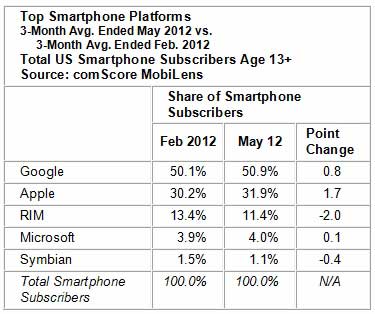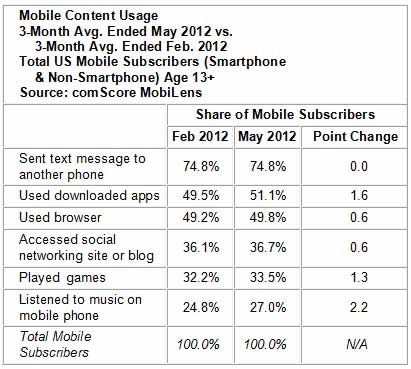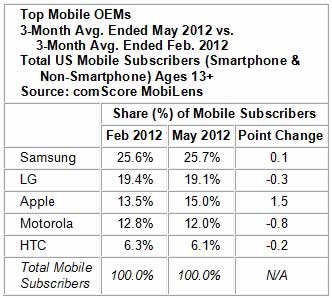Both Google Android and Apple continued to increase their share of US smartphone subscribers in the US: Android reached nearly 51%, while Apple captured 32%, according to data from the comScore MobiLens service for the three-month period ended May 2012.
Nearly 75% of US mobile subscribers used text messaging--the most popular type of content use--on their mobile device (not just smartphones).
Samsung remained the top mobile handset manufacturer overall with 25.7% market share.
Smartphone Platform Market Share
Nearly 110 million people in the US owned smartphones during the three months ended in May, up 5% from the three months ended February.

Google Android was the top smartphone platform with 50.9% market share (up 0.8 percentage points).
Five years after the release of the first iPhone, Apple's share of the smartphone market reached 31.9% in May (up 1.7 percentage points).
RIM ranked third with 11.4% share, followed by Microsoft (4.0%) and Symbian (1.1%).
Mobile Content Usage
In May, 74.8% of US mobile subscribers used text messaging on their mobile device.

Downloaded applications were used by 51.1% of subscribers (up 1.6 percentage points), while browsers were used by 49.8% (up 0.6 percentage points).
Accessing of social networking sites or blogs increased 0.6 percentage points to 36.7% of mobile subscribers.
Game-playing was done by 33.5% of the mobile audience (up 1.3 percentage points), while 27.0% listened to music on their phones (up 2.2 percentage points).
OEM Market Share
For the three-month average period ending in May, 234 million Americans age 13 and older used mobile devices.
Device manufacturer Samsung was the top OEM with 25.7% of US mobile subscribers (up 0.1 percentage points), followed by LG with 19.1% share.

Apple continued to increase its share in the OEM market, ranking third with 15.0% (up 1.5 percentage points), followed by Motorola with 12.0% and HTC with 6.1%.
About the data: MobiLens data is derived from an online survey of a nationally representative sample of mobile subscribers age 13 and older. Data on mobile phone usage refers to a respondent's primary mobile phone and does not include data related to a respondent's secondary device.



